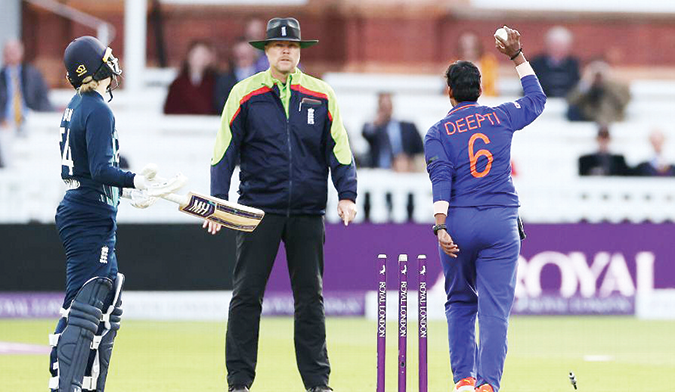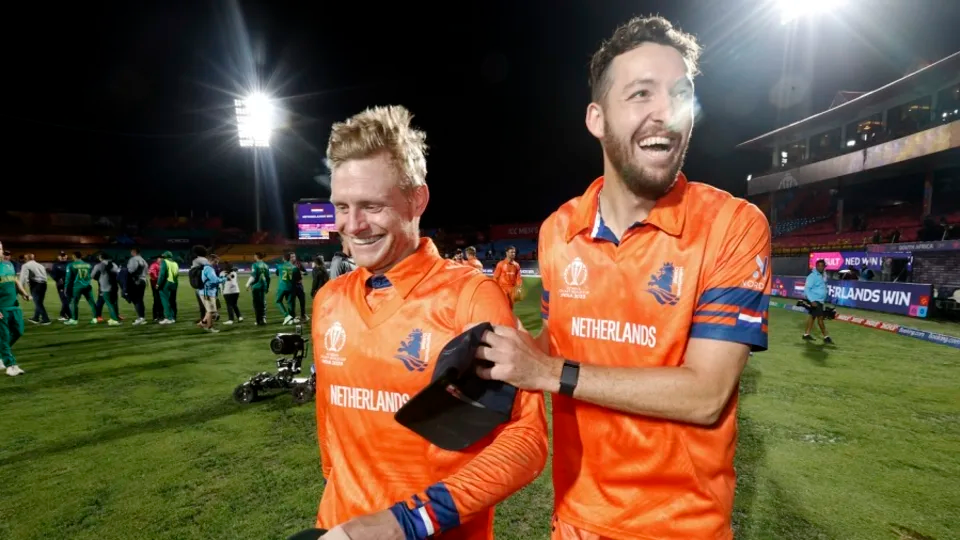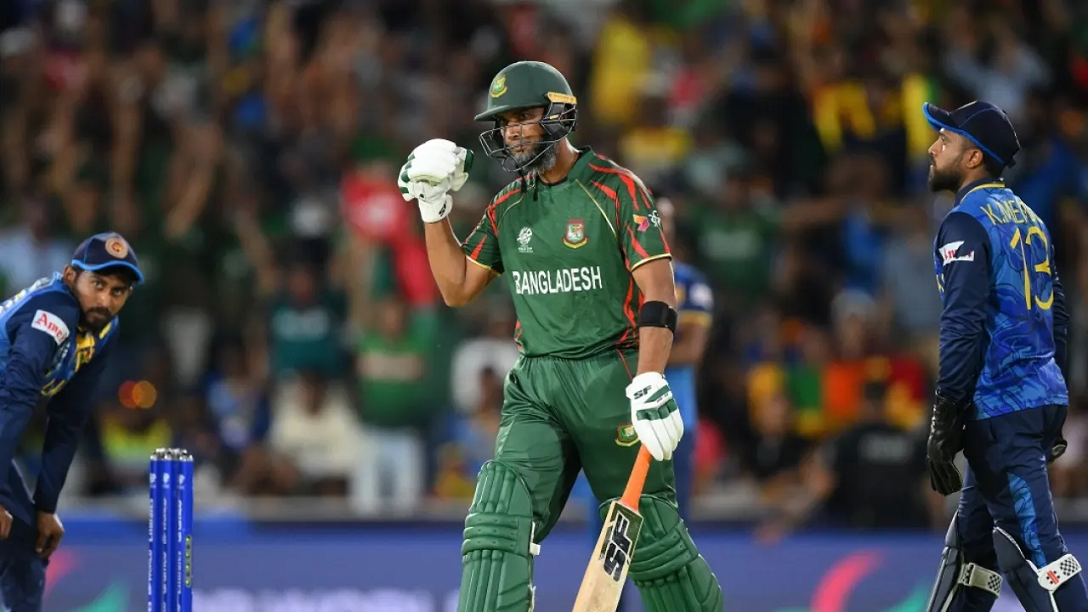Sports
MCC throws renewed support behind bowlers running out non-striker’s leaving the crease

The MCC World Cricket Committee has reaffirmed its stance on the matter of bowlers who run out non-strikers leaving the crease prior to delivery – colloquially referred to as a “Mankad” – which may help settle the cries for less severe punishment than the batter losing their wicket. In the same statement issued on Thursday following a meeting of the committee members in Dubai, the MCC also called for “calm across the global game following several high-profile incidents in a relatively short space of time.”
The hot-button debate generated renewed interest last September when India allrounder Deepti Sharma ran out England’s Charlie Dean for the game-clinching wicket in the 44th over of the third ODI at Lord’s which India won by 16 runs. Dean was on 47 off 80 balls at the time trying to rally her side which was chasing a target of 170. A detailed analysis conducted by ESPNcricinfo subsequently showed that Dean had left her crease early at the non-striker’s end on 72 occasions prior to being run out.
Deepti received support from captain Harmanpreet Kaur in the immediate aftermath of the incident during a post-match interview, saying, “Whatever we have done, I don’t think it was any crime. It is part of the game and is an ICC rule, and I think we just need to back our player.” The MCC World Cricket Committee made clear in its statement released on Thursday that the batter is at fault in such a scenario and that “there is no precedent to require a bowler to give a warning to a batter, confirming they are completely within their right to dismiss the batter on their first occasion they break the Law.”
The World Cricket Committee pointedly stated that such dismissals would not happen if non-strikers are “complying with the Law and remaining within their ground until they have seen the ball being released from the bowler’s hand.” In other words, it is the batter’s responsibility to avoid being dismissed like this, just as it is their responsibility to avoid being dismissed bowled or lbw or caught.
“The bowler is not the villain here,” Committee member Kumar Sangakkara said. “Every batter has a choice; to stay in their ground, or risk being given out if they try to steal ground. If they choose the latter, they are the ones who are breaking the Law.”
Running non-strikers out for backing up too far tends to foster the argument that it isn’t so big a mistake that it should cost a wicket. There is also a fear that normalising it would have a negative effect at grassroots level. But MCC World Cricket Committee chairman Mike Gatting disagrees.
“We have seen suggestions that this method of dismissal will be attempted more and more at recreational level and there is the possibility of matches descending into chaos,” Gatting said. “Whilst attempts may increase in the short term, we would expect batters to learn their responsibilities under the Laws very quickly and drive it out of prominence.”
“Our stance on this is simple – batters must not steal ground if they do not wish to be given out in this manner. Nor should they be expecting to be given a warning if they do. If all non-strikers only left the popping crease once the ball had been released, there would never be the need for such a dismissal again.
“The game is in a place where it should be able to self-regulate on this dismissal but there needs to be a Law in place, as we can’t have a situation whereby batters are able to gain ground without bowlers being able to do anything about it.”
The issue came under more scrutiny once again during a two week stretch in January where a spate of incidents happened across franchise cricket as well as men’s and women’s international cricket. The first incident in the sequence took place on January 3 in a Big Bash League match between Melbourne Stars and Melbourne Renegades. Stars captain Adam Zampa attempted to remove the bails with Renegades batter Tom Rogers well outside of his crease, but umpires ruled the appeal not out deeming that Zampa had gone past the point in his delivery action “where the bowler would normally have been expected to release the ball”.
This specific incident resulted in the MCC releasing a statement on January 19 to make a slight adjustment in the wording of Law 38.3.In a different incident on January 10, India men’s captain Rohit Sharma chose to withdraw an appeal made after fast bowler Mohammed Shami removed the bails to catch Sri Lanka captain out of his crease in the final over of the first ODI at Guwahati in January. Shanaka was on 98 at the time and the reprieve allowed him to score a century in a match that India won a few balls later by 67 runs defending a total of 373. The incident sparked debates about whether the dismissal should be attempted only at certain moments of a match versus being fair game for the entirety of play.
Just five days later, Pakistan Women’s U19 bowler Zaib-un-Nisa ran out Rwanda batter Shakila Niyomuhoza in an opening round fixture at the ICC Women’s U-19 T20 World Cup in South Africa. The run-out occurred in the final over of the first innings in which Rwanda finished on 106 for 8 before Pakistan chased the target down to win by eight wickets with 13 balls to spare.
(Cricinfo)
Sports
England face Australia in the battle of champions

The first truly heavyweight clash of this expanded T20 World Cup format comes freighted with both history and subplots. A rematch of the 2010 World T20 final at Kensington Oval, the match pits Jos Buttler’s defending champions – who are aiming to become the first team to retain the trophy – against the Australian winning machine, victors at the 2021 edition and current world title-holders in Test and ODI cricket. And that’s before you throw in the Ashes for afters.
Already there is added pressure on England, after the rain in Bridgetown led to a share of the points in their opener against Scotland (and that having conceded 90 runs from 10 overs without taking a wicket in a tepid bowling display). Lose to their oldest rivals and it will leave their Super 8 prospects open to being waylaid by the perils of net run-rate calculations, or worse.
The Scotland match was the third abandonment in five suffered by England, after a rain-affected home series against Pakistan, which has clearly hampered their readiness for this campaign after almost six months without playing T20 together. It does not take much for a side to click in this format – and England looked in decent shape when they did get on the field against Pakistan – but Buttler will be anxious for things to go their way on Saturday, if only to avoid further questions referencing the team’s disastrous ODI World Cup defence last year.
Australia, under the laidback leadership of Mitchell Marsh would love nothing more than to add to the English sense of jeopardy – having helped bundle them out of the tournament in India on the way to taking the crown. Their head to head record is less impressive in T20 however, with England having won six of the last seven completed encounters, as well as that 2010 final.
Despite a wobble with the bat, Australia avoided mishap against Oman earlier in the week, the experience of David Warner and Marcus Stoinis shining through in difficult batting conditions. Surfaces in the Caribbean – not to mention those games staged in the USA – have already had teams scratching their heads; rather than the “slug-fest” England had prepared for, following a high-scoring tour of the Caribbean in December, it looks as if boxing smart may be the way to go.
Speaking of Warner, this could be the last time he faces up against England in national colours – and another match-winning contribution would likely reduce the chances of them meeting again in the knockouts. On the other side of the card is Jofra Archer, fresh from an emotional maiden outing at Kensington Oval and ready to take on Australia for the first time in any format since 2020. Can Mark Wood fire up England’s campaign, as he did during last summer’s Ashes? Will Pat Cummins be back to harass the old enemy once again? Seconds out, it’s almost time to rumble.
Cummins is set to return after being rested for the Oman game, which saw Mitchell Starc leave the field with cramp. Starc is understood to be fine and could keep his place – which would likely see Nathan Ellis miss out. Marsh is still not fit to bowl, with Australia likely to continue with the allrounder combination of Stoinis and Maxwell to give them cover.
Australia (probable XI): David Warner, Travis Head, Mitchell Marsh (capt), Glenn Maxwell, Marcus Stoinis, Josh Inglis (wk), Tim David, Pat Cummins, Nathan Ellis/Mitchell Starc, Adam Zampa, Josh Hazlewood
The one change England may consider is Reece Topley coming in for Wood, with the expectation that there will be some rotation among the seamers through the course of the tournament.
England (probable XI): Phil Salt, Jos Buttler (capt & wk), Will Jacks, Jonny Bairstow, Harry Brook, Liam Livingstone, Moeen Ali, Chris Jordan, Jofra Archer, Adil Rashid, Reece Topley/Mark Wood
[Cricinfo]
Sports
South Africa up against their bogey team in batter-unfriendly New York

Once is coincidence, twice is a clue, and three times is proof.
To paraphrase Agatha Christie, that is the narrative around South Africa’s meeting with Netherlands at this T20 World Cup.
The Dutch beat South Africa at the 2022 tournament and ended their semi-final hopes in a match where South Africa appeared to be sleep walking, and then beat them again at the 2023 ODI World Cup, where they exposed South Africa’s vulnerability in the chase. If they to do the treble, not only will Netherlands take the lead in Group D, but they will offer conclusive evidence of the threat they pose to Full Members, especially South Africa.
Of course, it will take some doing after South Africa’s opening performance against Sri Lanka, where they reduced their opposition to their lowest T20I total and chased it down in fairly straightforward fashion thanks to the most stable middle-order of their white-ball era. In Aiden Markram, Tristan Stubbs, Heinrich Klaasen and David Miller, South Africa have bankers and big-hitters and, for this match, they also have the advantage of experience. They’ve already played at Eisenhower Park, and have first-hand knowledge that run-scoring doesn’t come easily;Klassen said they are prepared to use their “cricket brains” and play “smarter cricket”.
But the conditions could be good news for Netherlands, who are not naturally a line-up of big hitters and build their innings on a foundation of turning ones into twos. In other words, they tend to take a slightly more conservative approach to batting, which may work well here, but they’ll be wary of the uneven bounce of the surface and will have to come up with plans to counterattack especially against South Africa’s seamers. Their own bowlers were exemplary in Dallas and will look to build on that performance against a line-up that will likely be more proactive than Nepal’s, but who they have managed to keep quiet not once, but twice in the past. Third time’s the charm, they say.
Anrich Nortje’s stunning return to form against Sri Lanka means South Africa may not have to tinker with the bowling combination, and Gerald Coetzee and Tabraiz Shamsi may have to wait their turns to get a game. The batting line-up should be unchanged, with no space for Ryan Rickelton yet.
South Africa: Quinton de Kock (wk), Reeza Hendricks, Aiden Markam, Tristan Stubbs, Heinrich Klaasen (wk), David Miller, Marco Jansen, Keshav Maharaj, Kagiso Rabada, Ottneil Baartman, Anrich Nortje
Conditions in New York may tempt Netherlands to include an extra seamer and they have Kyle Klein in their squad. But it could come at the expense of a shortened batting line-up and they may not want to risk that.
Netherlands: Michael Levitt, Max O’Dowd, Vikramjit Singh, Sybrand Engelbrecht, Scott Edwards (capt, wk), Bas de Leede, Teja Nidamanuru, Logan van Beek, Tim Pringle, Paul van Meekeren, Vivian Kingma
[Cricinfo]
Latest News
Mustafizur, Rishad, Hridoy dazzle in Bangladesh’s tight two-wicket win over Sri Lanka

Nuwan Thushara’s last over brought Sri Lanka screaming back into the match,as he first bowled Rishad Hossain, and then nailed Taskin Ahmed in front of the stumps with a pinpoint swinging yorker. This left Bangladesh eight wickets down, with 12 runs still to get.
However, the experienced Mahmudullah was at the crease for Bangladesh, and despite some further nervy moments, pushed Bangladesh across the line off the last ball of the 19th over.
But this was a match chiefly decided by Bangladesh’s own outstanding bowling. Mustafizur Rahman was the best among them, using shorter lengths and his cutters efficiently, to claim figures of 3 for 17. Rishad Hossain’s three-for through the middle overs also kept Sri Lanka quiet.
Mustafizur was instrumental in Sri Lanka’s downward spiral through the middle overs, which culminated in a crash-and-burn end. Ultimately, their inability to find boundaries, or even rotate strike against good Bangladesh bowling resulted in their downfall. A score of 125 for 9 always seemed poor on a decent pitch, even if their bowlers made a match of it in the end.
Brief scores:
Bangladesh 125 for 8 in 19 overs (Towhid Hridoy 40, Litton Das 36; Dhanajaya de Silva 1-11, Nuwan Thushara 4-18, Wanidu Hasaranga 2-32, Matheesha Pathirana 1-27) beat Sri Lanka124 for 9 in 20 overs (Pathum Nissanka 47, Dhananjaya de Silva 21; Tanzim Hasan Sakib 1-24, Taskin Ahmed 2-25, Mustafizur Rahman 3-17, Rishad Hossain 3-22) by two wickets
[Cricinfo]





















